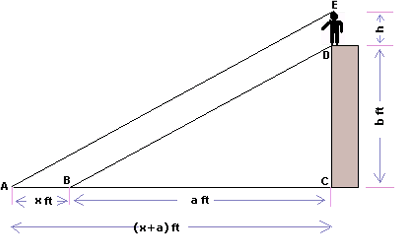Indirect Measurement
Definition Of Indirect Measurement
Indirect measurement is a technique that uses proportions to find a measurement when direct measurement is not possible.
Video Examples: Indirect Measurement
Example of Indirect Measurement
The length of a pole in a picture is given as 4 inches. The scale of the picture is given to be 1 inch : 13 inches. By setting up a proportion, the length n of the actual pole can be found.

Solving the proportion, we get n = 52 inches.
Solved Example on Indirect Measurement
Ques: A boy stands on the top of a building and the total length of shadows of the building and the boy is (x + a) ft and the length of the shadow of the boy alone is x ft. If the height of the building is b ft, then find the height of the boy. [Given x = 8, a = 160, b = 80.]

Choices:
A. 4 ft
B. 3.5 ft
C. 3 ft
D. None of the above
Correct Answer: A
Solution:
Step 1: Let h be the height of the boy.
Step 2: ΔACE ~ ΔBCD, because the measure of angle EAC = measure of angle DBC and the measure of angle C = measure of angle C.
Step 3: Corresponding sides of similar triangles are proportional.
Step 4: The proportion here is:
 Step 5: 160(h + 80) = 168 × 80 [Write the cross products.]
Step 5: 160(h + 80) = 168 × 80 [Write the cross products.]
Step 6: 160h + 12,800 = 13,440 [Multiply.]
Step 7: 160h = 640 [Simplify.]
Step 8: h = 4 [Divide both sides by 160 and Simplify.]
Step 9: So, the height of the boy is 4 ft.
- Scale-Drawings-Gr-7